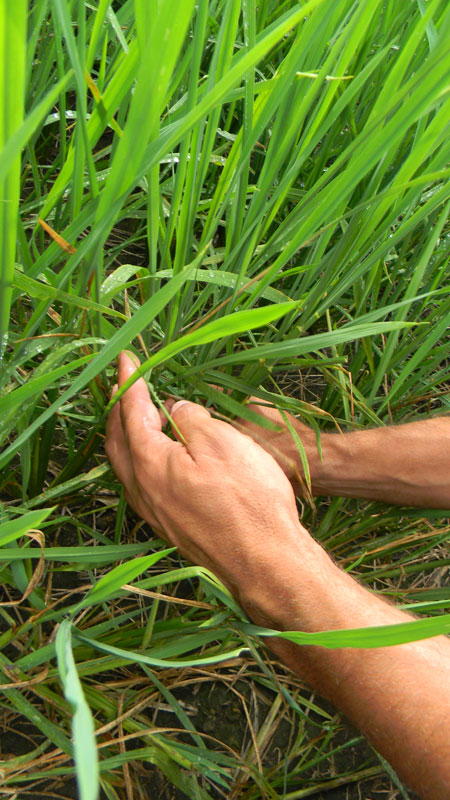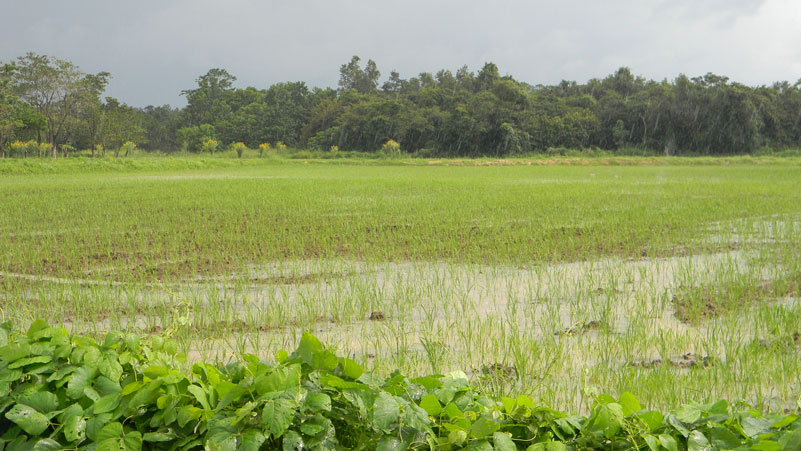EARTH University promotes advances in rice production
About two years ago, Diddier Moreira, farm manager at the EARTH-La Flor Campus in Guanacaste, was approached with the idea of testing an innovative approach to rice production: SRI.
SRI, or the System of Rice Intensification, is a method for growing rice that has been used since the early 1980’s. It was developed in Madagascar, off the eastern coast of Africa, by Henri de Laulanie, a French priest who began cultivating rice with wider spacing in a square pattern, which ultimately increased the yield of the rice produced by 80 to 90 percent.
“We started the SRI project because EARTH has always believed in the importance of promoting sustainable production systems,” explained Diddier, an EARTH alumnus (’94) who grew up on a banana farm in Siquirres near EARTH’s main campus. “That is what we did with bananas on EARTH’s campus in Guácimo, which was considered a controversial crop from an environmental perspective.”
Today, rice is also the focus of much controversy, said Diddier, due to the amount of water required under conventional production methods. Conversely, the SRI system utilizes about 50 percent less water than the conventional process. This is particularly important in the Guanacaste province of Costa Rica, where water is scarce six months out of the year.

EARTH-La Flor currently grows conventional rice on 155 hectares and three months ago, planted 1.5 hectares using the SRI system. Diddier mentioned that they will begin planting additional acres using the SRI model at EARTH-La Flor next month.
EARTH Professor Jorge Arce explained the importance of EARTH learning about and implementing SRI.
“Rice is one of the principal crops in Costa Rica,” said Arce, who has more than 35 years of experience in tropical agriculture. “Any improvement to rice production can have a big impact.”
Arce strongly believes in the importance of furthering research on this crop and that EARTH-La Flor can play an important role in promoting new technologies.
“The SRI technology is new for us and we must test it; we must prove it. In the process, we might have to make adaptations,” Arce said.
Under the SRI system, fewer agricultural inputs are used. For instance, instead of using herbicides the team at EARTH-La Flor is controlling weeds in the SRI fields manually. Since the fields aren’t flooded with water, as they are under traditional growing methods, weeds grow slower.
Managing weed growth effectively is important to maintaining the quality of the rice, the amount of nutrients the crop receives during the year and as result the value of the crop in the market.
“Manual weed control benefits the environment, but it can increase expenses,” professor Arce explains. However, being more sustainable adds value to the product that some buyers and consumers are willing to pay a premium.
In an effort to promote more sustainable rice production, EARTH University held an international conference last week to discuss the benefits of the SRI system. One of the conference’s main outcomes was the creation of an international network of institutions and farmers working in SRI.

“We are going to form a network in different countries where we will stay in contact and exchange knowledge and experiences with the SRI system,” professor Arce said.
In the last few weeks, Thailand, the world’s top rice exporter, has been heavily affected by torrential rains, and as a result, 1.4 million hectares of their rice plantations were destroyed.
Experts say this will drive the price of the crop from $625 a ton to $750 next month, which may affect Costa Ricans’ pockets since between 20-40 percent of the rice consumed in Costa Rica is imported.
“Can you imagine a Costa Rican without his or her rice?” professor Arce asked. “The Costa Rican diet depends heavily on rice for breakfast, lunch and dinner.”
SRI promises higher crop yields under a low-water, low-input model. If EARTH can validate that on Costa Rican soil, it could convince other rice farmers to adopt the system. That in turn could help Costa Rican rice farmers to increase production and reduce their environmental footprint, which would have lasting benefits to growers, consumers and the planet.




